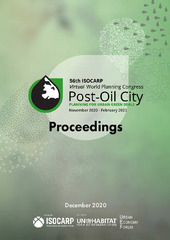Приказ основних података о документу
Virtual public participation during the Covid-19 crises Hype or new normal for city planning?
| dc.creator | Cilliers, Juaneé | |
| dc.creator | Simarmata, Hendricus Andy | |
| dc.creator | Taufiqurrahman, T. | |
| dc.creator | Olufemi, Olusola | |
| dc.creator | Cimadomo, Guido | |
| dc.creator | Pantić, Marijana | |
| dc.creator | Cap, Constant | |
| dc.creator | Treske, Eric | |
| dc.creator | Kumar, Rajendra | |
| dc.creator | Nakil, Seemantini | |
| dc.creator | Van den Berg, Johan | |
| dc.creator | Holmquist, Kate | |
| dc.creator | Montaño, Fernando | |
| dc.creator | Torres, Sally | |
| dc.creator | D’hondt, Frank | |
| dc.date.accessioned | 2022-05-05T09:00:01Z | |
| dc.date.available | 2022-05-05T09:00:01Z | |
| dc.date.issued | 2020 | |
| dc.identifier.isbn | 978-90-75524-67-3 | |
| dc.identifier.uri | http://raumplan.iaus.ac.rs/handle/123456789/633 | |
| dc.description.abstract | City and Regional planning should be accompanied by a thorough understanding of the contemporary social dynamics of the place and the implications it has for the people and other species who inhabit and use these places. As a result, territorial planning has been increasingly linked to participatory planning approaches in most politically and fiscally decentralised countries, to create sustainable living spaces through a bottom-up approach. Participatory planning again aiming to translate global solutions locally, giving local accents. The recent Covid19 health and related economic crises brought even more complexity to the planning table, emphasising the need for supplementary stakeholder and public participation using virtual platforms. Thanks to the pandemic crisis, planners across the globe are increasingly engaged with virtual participatory approaches, some with more success than others, due to various social, economic and cultural reasons. In an attempt to contextualise the challenges and opportunities of virtual participatory planning, this paper captures reflections of purposefully selected professional planners, all members of the International Society of City and Regional Planners (ISOCARP), who indicated an affinity with participatory planning approaches and the challenges and opportunities that the virtual platform provides. Specific focus was placed on a) challenges of virtual planning and b) opportunities of virtual participation - to draw conclusions on whether virtual participatory planning is only a hype, or would become the new normal for city and regional planning. | sr |
| dc.language.iso | en | sr |
| dc.publisher | ISOCARP | sr |
| dc.relation | info:eu-repo/grantAgreement/MESTD/inst-2020/200006/RS// | sr |
| dc.rights | openAccess | sr |
| dc.source | Proceedings of the 56th ISOCARP World Planning Congress “Post-Oil City: Planning for Urban Green Deals” | sr |
| dc.subject | Participatory city and regional planning | sr |
| dc.subject | virtual participation | sr |
| dc.subject | Covid-19 | sr |
| dc.subject | sustainable places | sr |
| dc.title | Virtual public participation during the Covid-19 crises Hype or new normal for city planning? | sr |
| dc.type | conferenceObject | sr |
| dc.rights.license | ARR | sr |
| dc.citation.spage | 1513 | |
| dc.citation.epage | 1525 | |
| dc.citation.rank | M33 | |
| dc.description.other | Editors: Piotr Lorens and Hangwelani Hope Magidimisha | sr |
| dc.identifier.fulltext | http://raumplan.iaus.ac.rs/bitstream/id/2702/Cilliers_et_al_ISOCARP_Congress.pdf | |
| dc.identifier.rcub | https://hdl.handle.net/21.15107/rcub_raumplan_633 | |
| dc.type.version | publishedVersion | sr |

